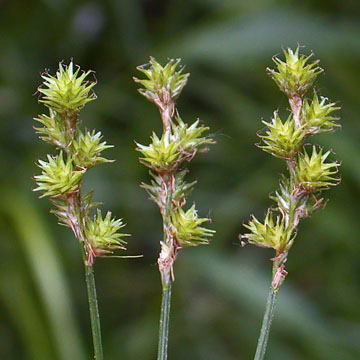

Carex normalis - (image 1 of 4)
Taxonomy
Family: Cyperaceae
Section Ovales
Habitat
Moist to somewhat dry fields, thickets, open woods.
Associates
Distribution
ME to MI and SD, south to NC, OH, MO, and OK.
Morphology
Tufted perennial, 30-80 cm, leafy-stemmed; aphyllopodic; leaves 2.5-6 mm wide, shorter than the stem; sheaths loosely clasping, hyaline ventrally, green mottled; inflorescence 3-5 cm; spikes 5-10, gynaecandrous, subglobose, 6-9 mm, sessile, loosely aggregated or the lowermost sometimes separate; pistillate scales ovate, much shorter than the perigynia, hyaline, slightly brown with green midvein, acute or obtuse; perigynia ascending, planoconvex, ovate, green or pale greenish-brown, 3.3-4.4 mm, 2-2.5 times as long as wide, broadest at 1/4 to 1/3 their length, finely nerved dorsally, lightly or obscurely nerved ventrally, gradually tapering to a flat, serrulate beak; achene lenticular, 1.5-2 mm long and 1 mm wide.
Notes
Fruiting June to August
Wetland indicator: FACW
Carex tincta Fernald is similar but has brown scales with pale margins, leaf sheaths tightly clasping and evenly colored, and blades 1.5-3.5 mm wide; Gleason & Cronquist speculated that it may be derived from a hybrid of C. normalis and C. foenea. It is most common in New England.
References
Ball, P.W. and A.A. Reznicek. 2002. Carex, In: Flora of North America Editorial Committee, Eds. Flora of North America North of Mexico. Volume 23. Oxford University Press, New York.
Gleason, Henry A. and A. Cronquist. 1991. Manual of Vascular Plants of
Northeastern United States and Adjacent Canada. Second Ed.
The New York Botanical Garden. Bronx, NY
|
© Michael Hough 2018 |